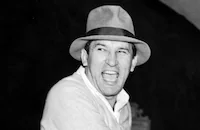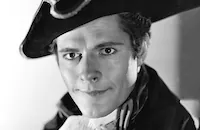Part of one's curiosity about Davis' affection for the film comes from her relatively small role. She doesn't even make it to the final reel, and in a film that's only 68 minutes long, that's little screen time indeed. In fact, co-star Margaret Lindsay is the picture's real leading lady. Of course, Davis never objected to smaller roles if they had enough meat to them. Two years after Fog Over Frisco, she fought unsuccessfully to play the one-scene role of Nana, the prostitute who inspires the notorious novel named for her in The Life of Emile Zola(1937). Clearly she saw something in Fog Over Frisco she could sink her teeth into.
But there really was more than that behind her dedication. For one thing, this was her happiest film with Dieterle, a director she had long admired. They had teamed already for the disastrous musical Fashions of 1934 and would get together again for the second version of The Maltese Falcon, Satan Met a Lady, a 1935 film so bad it led her to walk out on her Warner Bros. contract. Their only other teaming was Juarez, in which Davis played Mexico's mad Empress Carlotta, but that film was so dominated by male star Paul Muni that most of Davis' best work ended up on the cutting room floor. So, by default, Fog Over Frisco marked their best experience together.
The film also was her first with cameraman Tony Gaudio, a Warner Bros. stalwart she would later request on such pictures as The Letter (1940) and The Great Lie (1941). She always felt that he and costume designer Orry-Kelly had made her look believably glamorous in Fog Over Frisco, and for an actress fighting complaints from executives that she was lacking in sex appeal, that was a big breakthrough.
Of all the factor's involved in making Fog Over Frisco, however, the most important may have been timing. For months Davis had been fighting to convince studio head Jack Warner to lend her to RKO Pictures to play the role of Mildred, the cheap, two-timing waitress in W. Somerset Maughm's Of Human Bondage (1934). Warner was always reluctant to lend his contract stars to other studios, for fear they'd make too much money for the competition. Moreover, he thought playing such a thoroughly unpleasant character would destroy Davis' career before it even got off the ground. But Davis persisted as only she could. She may very well have accepted the secondary role in Fog Over Frisco to show Warner what a good team player she could be. It must have worked, because two weeks into filming, Warner notified her that he had worked out the loan to RKO (or, as he put it, "Go and hang yourself!"). A week after finishing Fog Over Frisco she started Of Human Bondage - the film that made her one of Hollywood's top dramatic stars. Word of mouth on her performance was so strong, that Warner promoted her from third billing in Fog Over Frisco to the star spot, eager to take advantage of Davis' success in a film he'd never wanted her to make in the first place.
Director: William Dieterle
Producer: Robert Lord
Screenplay: Robert N. Lee, Eugene Solow
Based on The Five Fragments by George Dyer
Cinematography: Tony Gaudio
Art Direction: Harold McLernon
Music: Leo F. Forbstein
Principal Cast: Bette Davis (Arlene Bradford), Donald Woods (Tony Sterling), Margaret Lindsay (Val Bradford), Lyle Talbot (Spencer Carleton), Hugh Herbert (Izzy Wright), Robert Barrat (Thorne), Irving Pichel (Jake Bellow), Alan Hale (Chief O'Malley), William Demarest (Spike Smith).
BW-69m.
by Frank Miller

































